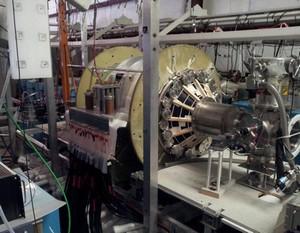Planetary securityNuclear fusion could power a rocket to take humans to Mars
NASA estimates a round-trip human expedition to Mars would take more than four years using current technology. The sheer amount of chemical rocket fuel needed in space would be extremely expensive — the launch costs alone would be more than $12 billion. Now, astronauts could be a step closer to our nearest planetary neighbor through a manipulation of nuclear fusion, the same energy that powers the sun and stars.

Test nuclear fusion-powered engine // Source: washington.edu
Human travel to Mars has long been regarded as the unachievable goal for space programs. Now, astronauts could be a step closer to our nearest planetary neighbor through a manipulation of nuclear fusion, the same energy that powers the sun and stars.
A University of Washington release reports that University of Washington researchers and scientists at a Redmond-based space-propulsion company are building components of a fusion-powered rocket aimed to clear many of the hurdles that block deep space travel, including long times in transit, exorbitant costs, and health risks.
“Using existing rocket fuels, it’s nearly impossible for humans to explore much beyond Earth,” said lead researcher John Slough, a UW research associate professor of aeronautics and astronautics. “We are hoping to give us a much more powerful source of energy in space that could eventually lead to making interplanetary travel commonplace.”
The project is funded through NASA’s Innovative Advanced Concepts Program. Last month at a symposium, Slough and his team from MSNW, of which he is president, presented their mission analysis for a trip to Mars, along with detailed computer modeling and initial experimental results. Theirs was one of a handful of projects awarded a second round of funding last fall after already receiving phase-one money in a field of fifteen projects chosen from more than 700 proposals.
NASA estimates a round-trip human expedition to Mars would take more than four years using current technology. The sheer amount of chemical rocket fuel needed in space would be extremely expensive — the launch costs alone would be more than $12 billion.
Slough and his team have published papers calculating the potential for 30- and 90-day expeditions to Mars using a rocket powered by fusion, which would make the trip more practical and less costly.
Is this really feasible, though?
Slough and his colleagues at MSNW think so. They have demonstrated successful lab tests of all portions of the process.
Now, the key will be combining each isolated test into a final experiment that produces fusion using this technology, Slough said.
The research team has developed a type of plasma that is encased in its own magnetic field. Nuclear fusion occurs when this plasma is compressed to high pressure with a magnetic field. The team has successfully tested this technique in the lab.
Only a small amount of fusion is needed to power a rocket — a small grain of sand of this material has the
